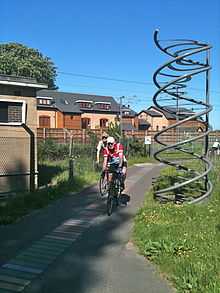National Cycle Route 11
NCN Route 11 is a Sustrans National Cycle Route connecting Harlow in Essex to King's Lynn in Norfolk.
Route
Harlow to Cambridge

Harlow | Bishop Stortford | Hinxton | Sawston | Cambridge
Intersects with NCR 51 in Cambridge.
A section of path, about two kilometres long, from Great Shelford to Addenbrookes Hospital in Cambridge, is decorated with over 10,000 lines of four colours representing the nucleotide sequence of the BRCA2 gene. This gene, implicated in early-onset breast cancer, was discovered in 1994; the discoverers included scientists from nearby Addenbrookes Hospital and The Sanger Centre, Hinxton.
This section of path also includes and commemorates the 10,000th mile of the National Cycle Network.
Cambridge to King's Lynn
Cambridge | Burwell | Wicken | Ely | Downham Market | Watlington | King's Lynn
Intersects with National Cycle Route 1 near King's Lynn
Proposed development
Wicken Fen Vision Spine Route
Route 11 between Cambridge and Ely had a gap in the route, due to the difficulties of crossing the many waterways of the Cambridgeshire Fens. In 2011, the new bridge over Swaffham Bulbeck Lode, and surfacing of several sections of cycle path enables complete use of the route. This section of route 11 had been called the Wicken Fen Vision Spine Route, but in 2011 was named the Lodes Way. The project involves the construction of 18 km of cycleway and of a number of bridges over the man-made waterways known as lodes.[1] The Lodes Way still has a foot bridge over Burwell Lode with restricted use. A new bridge is scheduled for completion in 2013.[1] The project has received funding of £600,000 from the Sustrans Connect2 scheme.[2]
References
- ↑ 1.0 1.1 "The Wicken Vision - Spine Route". National Trust. Retrieved 2011-12-30.
- ↑ "Cambridge to Wicken Fen walking and cycling network – now a step closer". Sustrans. 2009-03-04. Retrieved 2009-07-14.
| ||||||||||